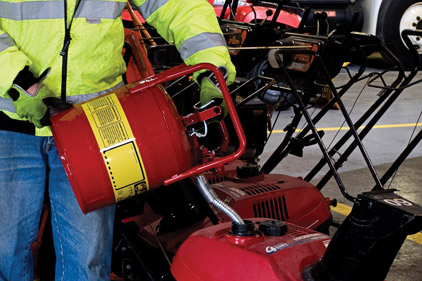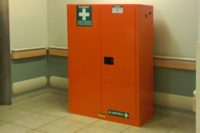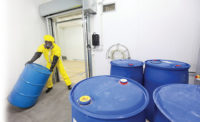A few months later, June, Industrial Safety and Hygiene News published an article under the headline “Every 2 Minutes a Fire Strikes.” Upon reading further, we learn that these are structural fires. The article goes on to say that the Bureau of Labor Statistics reported that in 2010, 187 workers died from fire or explosion. Workplace fire can and does occur at anytime.
Flammable liquids, more specifically, flammable liquid vapors are one cause of these fires. Late last year, a metal finisher in Syracuse was cited a total of $51,680 ($33,000 serious violations, $18,680 repeat violations). An excerpt from OSHA reads:
“Flammable vapors ignited in a storage room holding more than 800 gallons of flammable liquids, and a plant employee who tried to extinguish the fire sustained burns that were not life threatening. OSHA’s inspection identified several safety deficiencies involving the storage and dispensing of flammable liquids, including a lack of ventilation in the storage room. Additionally, the room was not constructed to meet the NFPA’s required fire-resistance rating, numerous containers of flammable liquids were open and uncovered, flammable liquids were dispensed without the nozzle and container being electrically bonded, and a lighter was allowed to be ignited in the storage room.”
In Canada, Ministry of Labour inspectors are checking flammable liquid practices. In November 2011, the sole proprietor of a synthetic marble and granite manufacturing plant in Ontario was fined $17,000 for various violations, among them:
- Flammable liquids were improperly stored
- The mixing area was not properly ventilated
- There was no system to contain spills
- The spray booth was missing a make-up air system
Let’s stop these fires before they start while avoiding penalties and fines. This article will address flammable liquids. It is a good place to begin.
Setting up the program
First, you should establish company procedures along with the equipment required for handling these hazardous materials. You can obtain information to assist you in setting up such a program from your fire insurance company, an OSHA office or website, and/or a manufacturer of equipment used for the storage and handling of flammables. Now re-evaluate the program you have just established according to the following criteria:
1. Does it comply with OSHA standards? Be sure it meets the Hazard Communication Standard, OSHA 29 CFR 1910.1200.
2. Does it oblige the user to follow safe procedures?
3. Is it fail-safe?
When the program meets these criteria, your regulations should be posted prominently in all areas where flammables are stored or used, and each employee who handles them should receive a personal copy.
The next step in the program should be a compulsory training for all personnel who handle flammables, or who are responsible for their safe storage and use. When considering flammable liquids handling or storing equipment, remember that OSHA does not “approve” such items. OSHA will, however, “accept” equipment “listed” by Underwriters’ Laboratories or “approved” by FM Global — provided that such equipment is being properly used.
Safety cabinets and safety cans are the most frequently used pieces of equipment in containment systems for flammable liquids. Here are some pointers to help you make the most appropriate selection for your own situation.
How to select a safety cabinet
1. Compliance with regulatory requirements.
Third-party testing is your best assurance of performance. Look for cabinets that are approved by FM Global. Federal, state and local regulations may apply. Contact your local Fire Marshal for guidance. OSHA 29 CFR 19 10.106 and NFPA Code 30 Section 9.5 are applicable.
2. Style preference
Typically the closure style of the cabinet door is a matter of personal preference. However, states and locales which follow either the International Fire Code or NFPA I mandate the use of self-closing cabinets. With this in mind, choose from three door styles: manual close, self-close, or bi-fold/sliding self-close. All three styles self-latch, whereas the bi-fold and self-close styles are equipped with a fusible-link device that will melt to automatically shut the doors in the event of a fire.
3. Chemical characteristics and capacity issues
Using color and labeling in your storage practices helps identify, organize and segregate liquids. It also aids fire department personnel to recognize hazards when responding to fire situations. Regulatory codes do not mandate the specific color of safety cabinets.
The industry, however, generally observes the following color schemes; yellow is used for flammables; red for paints, inks and other combustible liquids; and blue is designated for corrosives. Green is the norm for pesticides and insecticides. Determine if you are storing safety cans, 30- and 55-gallon drums, smaller paint cans, aerosols, 4-liter bottles, dispenser cans or other smaller containers. Check cabinet dimensions and descriptions.
This three-step process assists greatly in making the cabinet selection that best suits your needs. Whatever your choice, it is critical that good housekeeping and hygiene practices be followed to keep your cabinets in good working order. Containers must be stored sealed, and spills and residue must be cleaned up promptly and regularly. The room where the cabinets are placed should maintain a low humidity and be well ventilated.
Choosing the safety can
NFPA is specific on what is required of a safety can. Its basic purpose is the control of flammable vapors, while providing a convenient means of carrying, dispensing and storing up to five gallons (19L) of flammable liquid. 2012 NFPA Code 3.3.48 and OSHA 1910.1 06(a)(29) define a safety can as: “A listed (approved) container of not more than 5.3 gal (20L) capacity having a self-closing lid and spout cover and so designed that it will safely relieve internal pressure when subjected to fire exposure.”
Safety cans vent between 3 and 5 psig preventing possible rupture in the event of a fire. A flame arrester located in the spout prevents fire “flashback” when the cap is open.
Safety cans are manufactured in a variety of styles, sizes and colors. Coated steel, stainless steel and non-metallic, generally HDPE, are available. Your specific application will determine the style, size, color and material you should choose.
In an industrial plant, flammable liquids are commonly used to clean parts in bench cans, and rinse or wash tanks, and automatic washers. This equipment must be refilled periodically. Normally the flammable liquids are carried from storage areas or safety cabinets in a Type I single spout style of safety can. Type I cans come in capacities from 1 pint to 5 gallons. Application dictates size selection. For example, a 1-gallon bench container can be filled with less spill risk by using a small capacity safety can, rather than a larger 5-gallon safety can, even though either meets OSHA requirements. This is logical.
The industrial cleaning scenario described above requires only industrial grade solvents in most cases. Therefore a red coated steel safety can will serve
you well.
A Type II safety can should be used to fuel small motors or fill fuel tanks. The hose fits easily into the small opening. This reduces the chance of spills and waste while reducing fire hazards. A Type II safety can has two openings: one for filling, one for pouring. A vacuum relief valve opens automatically to assure smooth, even dispensing.
DOT (Dept. of Transportation) approved Type II safety cans are a must if you are transporting more than 1/3-gallon of a flammable on public roads. These cans are FM and DOT/UN approved. They are required for use in any commercial vehicle by DOT and OSHA when transporting flammable or combustible liquids on public roads and highways. Required safety features — over and above a Type II safety can — include handle drop protection and a lid locking device for transport.
How do you choose the correct color?
As with cabinets, color distinguishes content. Red is designated for a flammable; yellow means diesel. Blue commonly identifies kerosene. Green cans are used for oils.
Rough handling, or even just the regular use of corrosive liquids, shortens the life of any metal container. If you anticipate abusive conditions, select safety cans with non-metallic bodies. Molded from high-density polyethylene (HDPE) that is resistant to corrosive chemicals, these containers provide an impervious barrier to the contents, and resist dents, punctures and abrasion. Many corrosives can be safely stored in non-metallic safety cans, however, always check compatibility charts.
Finally, always use “listed” or “approved” safety cans in the workplace or on a jobsite. Never use plastic cans marked “gasoline” or “diesel” readily available in home centers or hardware stores at attractive prices. These containers are intended for consumer use around the home. They are not acceptable under OSHA regulations. I trust the information provided in this article has been helpful. For additional assistance, contact us at your convenience. www.justritemfg.com






